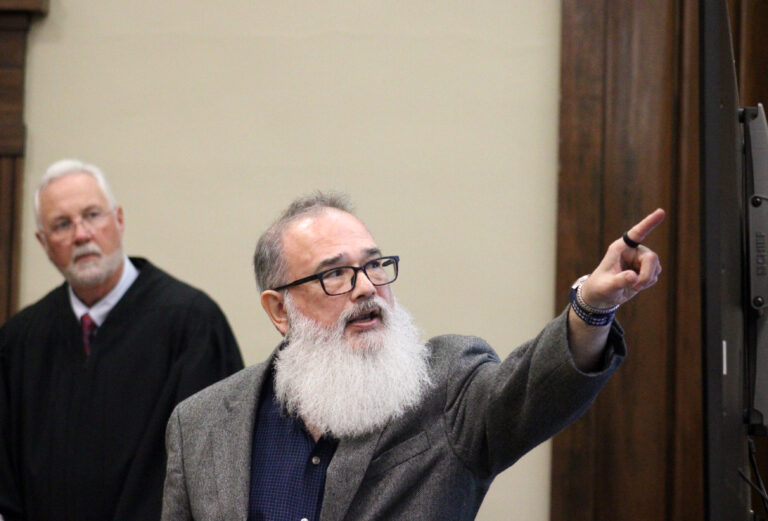School board focuses on tackling ‘vapedemic’
The Franklin County Schools have a vaping problem and it’s costing them money, as well as harming the health of students.
At a lengthy discussion at the May 24 board meeting, school board members listened as school officials outlined a situation in which students as young as those in elementary grades are being found using vape products.
And before being confronted in the bathrooms, many are flushing the vaping apparatus down the toilets, which has led to costly removals and repairs.
Anthony Croom, the district’s school safety officer, told the board that with the implementation of the Verkada system in one of the bathrooms, the school is “getting a lot less alerts.”
Verkada is an environmental sensor with camera integration that detects vapes, and monitors levels of carbon dioxide , temperature, noise, air quality, motion and total volatile organic compounds (TVOC). The vape detection sensors track the change in the air and alerts administrators through email and/or text message. Cameras are located in the hallway and when the sensor indicates a change, the camera in the hallway will take a screenshot of the student in the hallway.
When vaping is detected, the student is referred to administrators and disciplinary measures are imposed, said Principal Danielle Rosson. She said the actions taken begin with in-school suspension, and if that proves unsuccessful, further measures can include out-of-school suspensions, tobacco citations and even alternative placement.
“It typically depends if it is a first-time offense or a repeat action,” Rosson said. “Progressive discipline is put into place if we have repeat vapers. “
But, as Josh Gilbert, who oversees the district’s facilities, explained, the damage that results from vaping goes beyond harming students’ lungs.
“Students are flushing the vapes in the toilet,” he said. “One of the pumps was burned up due to a vape being lodged in the pump. We have had to call a sewage drain company three different times to fish vapes out of our drains.
“These vapes are aluminum, and I’ve fished through them,” he said, stressing that “I did have gloves on. They’re a bunch of plastic inside but they are wrapped with aluminum.
“I call it a ‘vapedemic’,” Gilbert said. “It’s definitely costing the school district a lot of money.”
Finance Director Shannon Venable said each time a sewage draining company has to be called in, the bill can run between $5,000 and $10,000.
Gilbert said it cost $6,000 to rebuild the pump that was destroyed, and $3,000 to clear the sewage lines.
School Board Chairman Stacy Kirvin asked about possible solutions, including a screening system to filter out vapes, or placing a special trash can in the bathroom labeled “for vapes only.”
He said his primary concern was to institute a pro-active program, in addition to the current no-vape signs around campus and anti-vaping and tobacco videos, that would discourage vaping by reminding students of the health hazards.
“They obviously don’t realize what a vape does to their lungs, it’s worse than a cigarette,” Kirvin said. “A fifth grader who starts vaping, he won’t be able to breathe by the time he’s an adult. They need to be educated on how dangerous these vapes are.”
He said students need to be reminded constantly of these dangers, recalling how his son kept after Kirvin’s father repeatedly about his habit of chewing tobacco. “And my dad quit,” he said.
“We need to install a smoking section at the school,” said Gilbert, half in jest but hearkening back to a time when smoking sections were found in teachers’, and even students’ lounges.
He said he was impressed with the effectiveness of the Verkada system. “The ones previously purchased are easily manipulated, they can hide the vapors,” said Gilbert. “This one is a lot more sensitive than our previously purchased vape detectors were. Them just walking through the detector it picks up that.
“If we can get that in the rest of the restrooms, I think we could definitely curb the issue for sure,” he said. “If we can get parents on board, it would definitely be beneficial.”
Board member Jared Mock said the vapes typically go for about $30. “It’s definitely something we have to figure out; in the long run it’s only going to get worse,” he said, noting that the earlier systems were ineffective,
“They literally blow the vapor smoke in those detectors and it does nothing,” he said. “They’re not scared at all.”
Both Rosson and Gilbert stressed that the problem is not limited to the schools, and is worsened by adults who either sell them to kids at stores and provide them to them.
“I am hearing (about it) more out of school than in school,” said Rosson. “They’re getting them from adults or from specific locations. We have adults handing them to minors and that’s a big issue. We need to figure out where they’re buying them and prosecuting them.
“The issue we have from this is that it is a challenge with the state attorney’s office whether they are going to take it (a case against parents) or drop it,” she said. “The issue is the teeth of citations.”
Gilbert said he knows of a sting operation at a local store, which resulted in the merchants being caught.
“I think we gotta get tough on the people selling them,” Kirvin said.
The problem is not limited to classrooms, it has surfaced on the buses, according to transportation manager Teresa Segree.
“We have 50 percent of kids vaping to and from school,” she said, noting that after reviewing videos regarding a bullying incident, “within five minutes we had three kids vaping on the bus. Discipline on the bus is just as important as discipline in the classroom.
“We found third graders vaping on our buses,” Segree said. “They hide it in the sleeve of their hoodie. They’re vaping and blowing it back in their sleeve, they’re doing it every day.
Segree said she found 15 so far this year off of videos. She said that after the fourth referral it’s five days off the bus, and a fifth incident means 10 days off of the bus.








Meet the Editor
David Adlerstein, The Apalachicola Times’ digital editor, started with the news outlet in January 2002 as a reporter.
Prior to then, David Adlerstein began as a newspaperman with a small Boston weekly, after graduating magna cum laude from Brandeis University in Waltham, Massachusetts. He later edited the weekly Bellville Times, and as business reporter for the daily Marion Star, both not far from his hometown of Columbus, Ohio.
In 1995, he moved to South Florida, and worked as a business reporter and editor of Medical Business newspaper. In Jan. 2002, he began with the Apalachicola Times, first as reporter and later as editor, and in Oct. 2020, also began editing the Port St. Joe Star.